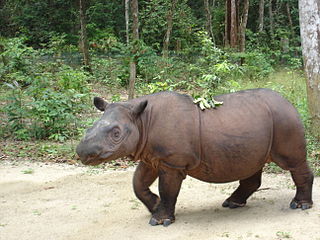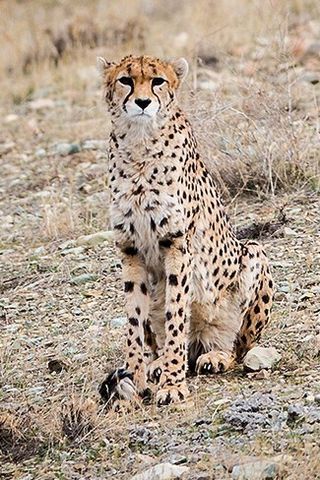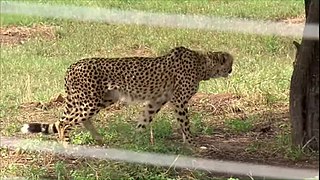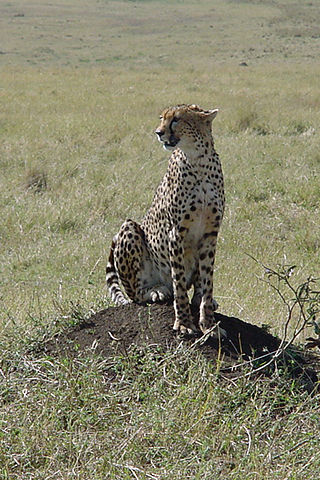
The cheetah is a large cat native to Africa and Southwest Asia. It is the fastest land animal, capable of running at 80 to 98 km/h, as such has evolved specialized adaptations for speed, including a light build, long thin legs and a long tail. It typically reaches 67–94 cm (26–37 in) at the shoulder, and the head-and-body length is between 1.1 and 1.5 m. Adults weigh between 21 and 72 kg. Its head is small and rounded, with a short snout and black tear-like facial streaks. The coat is typically tawny to creamy white or pale buff and is mostly covered with evenly spaced, solid black spots. Four subspecies are recognised.

Acinonyx is a genus within the Felidae family. The only living species of the genus, the cheetah, lives in open grasslands of Africa and Asia.

The Javan rhinoceros, also known as the Javan rhino, Sunda rhinoceros or lesser one-horned rhinoceros, is a very rare member of the family Rhinocerotidae and one of five extant rhinoceroses. It belongs to the Rhinoceros genus and has a mosaic, armour-like skin, is 3.1–3.2 m (10–10 ft) long and 1.4–1.7 m (4.6–5.6 ft) high. Its horn is usually shorter than 25 cm (9.8 in). Only adult bulls have horns. The Javan rhinoceros ranged from the islands of Java and Sumatra throughout Southeast Asia and into India and China. Today, it is critically endangered, with only one known population in the wild, and no individuals in captivity. It is one of the rarest large mammals on Earth, with a population of approximately 74 in Ujung Kulon National Park at the western tip of Java in Indonesia. The Javan rhinoceros population in Vietnam's Cat Tien National Park was declared to be locally extinct in 2011. The decline of Javan rhinoceros is attributed to poaching, primarily for its horns, which are highly valued in traditional Chinese medicine, fetching as much as US$30,000 per kg on the black market. As European presence in its range increased, trophy hunting also became a serious threat. Loss of habitat, especially as the result of wars, such as the Vietnam War, has also contributed to its decline and hindered recovery. The remaining range is within one nationally protected area, but it is still at risk from poachers, disease, and loss of genetic diversity leading to inbreeding depression.

The Sumatran rhinoceros, also known as the Sumatran rhino, hairy rhinoceros or Asian two-horned rhinoceros, is a rare member of the family Rhinocerotidae and one of five extant species of rhinoceros; it is the only extant species of the genus Dicerorhinus. It is the smallest rhinoceros, although it is still a large mammal; it stands 112–145 cm (44–57 in) high at the shoulder, with a head-and-body length of 2.36–3.18 m and a tail of 35–70 cm (14–28 in). The weight is reported to range from 500–1,000 kg (1,100–2,200 lb), averaging 700–800 kg (1,500–1,800 lb). Like both African species, it has two horns; the larger is the nasal horn, typically 15–25 cm (5.9–9.8 in), while the other horn is typically a stub. A coat of reddish-brown hair covers most of the Sumatran rhino's body.

Rhinoceros is a genus comprising one-horned rhinoceroses. This scientific name was proposed by Swedish taxonomist Carl Linnaeus in 1758. The genus contains two species, the Indian rhinoceros and the Javan rhinoceros. Although both members are threatened, the Javan rhinoceros is one of the most endangered large mammals in the world with only 60 individuals surviving in Java (Indonesia). The word 'rhinoceros' is of Greek origin meaning "nose-horn".

The Asiatic cheetah is a critically endangered cheetah subspecies currently only surviving in Iran. It once occurred from the Arabian Peninsula and the Near East to the Caspian region, Transcaucasus, Kyzylkum Desert and northern South Asia, but was extirpated in these regions during the 20th century. The Asiatic cheetah diverged from the cheetah population in Africa between 32,000 and 67,000 years ago.
Endangered mammals of India are the mammal species in India that are listed as threatened in the International Union for Conservation of Nature and Natural Resources (IUCN) Red List of Threatened Animals

The Northwest African cheetah, also known as the Saharan cheetah, is a cheetah subspecies native to the Sahara and the Sahel. It is listed as Critically Endangered on the IUCN Red List. In 2008, the population was suspected to number less than 250 mature individuals.
The wildlife of Iran include the fauna and flora of Iran.

More than 70 years after India's native subspecies of the cheetah—the Asiatic cheetah —became extinct there, small numbers of Southeast African cheetah have been flown in from Namibia and South Africa to a national park in India. The experiment has been permitted by India's supreme court on a short-term basis to test long-term adaptation. The Asiatic subspecies is now found only in Iran in critically endangered numbers.
Htamanthi Wildlife Sanctuary is a 2,150.73 km2 (830.40 sq mi) large protected area in northern Myanmar. It was established in 1974 in the Sagaing Region.

The Indian aurochs is an extinct aurochs subspecies that is considered the wild ancestor of the domestic zebu cattle, which is mainly found in the Indian subcontinent and has been introduced in many other parts of the world, like Africa and South America. In contrast, the domesticated taurine cattle breeds, which are native to Europe, the Near East, and other parts of the world, are descendants of the Eurasian aurochs. According to IUCN, the Indian aurochs disappeared before the 13th century AD, leaving only the Bos primigenius primigenius, whose range was by then restricted to Europe. The wild population of Indian aurochs was likely extinct millennia earlier than that; the most recent skeletal remains, from Uttar Pradesh, date from around 1,800 BC.

The Javan elephant was proposed by Paules Edward Pieris Deraniyagala in 1953, based on an illustration of a carving on the Buddhist monument of Borobudur in Java. He thought that the Asian elephant had indeed existed on the island and had gone extinct. It may be considered synonymous with the Sumatran elephant.

The East African cheetah, is a cheetah population in East Africa. It lives in grasslands and savannas of Tanzania, Kenya, Uganda and Somalia. The cheetah inhabits mainly the Serengeti ecosystem, including Maasai Mara, and the Tsavo landscape.

The Northeast African cheetah is a cheetah subspecies occurring in Northeast Africa. Contemporary records are known in South Sudan and Ethiopia, but population status in Eritrea, Djibouti, Somalia and Sudan is unknown.

The Northern Sumatran rhinoceros, also known as Chittagong rhinoceros or northern hairy rhinoceros was the most widespread subspecies of Sumatran rhinoceros, as well as the only known subspecies native to mainland Asia.

The Southeast African cheetah is the nominate cheetah subspecies native to East and Southern Africa. The Southern African cheetah lives mainly in the lowland areas and deserts of the Kalahari, the savannahs of Okavango Delta, and the grasslands of the Transvaal region in South Africa. In Namibia, cheetahs are mostly found in farmlands. In India, four cheetahs of the subspecies are living in Kuno National Park in Madhya Pradesh after having been introduced there.

The Ussuri dhole, also known as the Eastern Asiatic dhole and the Chinese dhole, is the nominate subspecies of the dhole wild dog native to Asia. The Ussuri dhole subspecies is originally native to China and sections of Manchuria, the Amur River, the Korean Peninsula and Mongolia; however, it is presumed regionally extinct or extirpated in most of its historical range in the country, and likely found in fragmented populations in the Russian Far East.

The lesser Indian rhinoceros, also known as the Indian Javan rhinoceros, or the hornless rhinoceros, is an extinct subspecies of the Javan rhinoceros that was native to northeastern India, Bangladesh, and Myanmar. Its common name was based of off the Indian Rhinoceros, being the Greater Indian rhinoceros or Great Indian rhinoceros.















